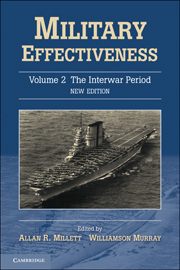Book contents
- Frontmatter
- Contents
- List of Contributors
- Introduction: Military Effectiveness Twenty Years After
- Maps
- 1 The Soviet Armed Forces in the Interwar Period
- 2 The French Armed Forces, 1918–40
- 3 The Military Effectiveness of the US Armed Forces, 1919–39
- 4 The British Armed Forces, 1918–39
- 5 Japanese Military Effectiveness: The Interwar Period
- 6 The Italian Armed Forces, 1918–40
- 7 German Military Effectiveness between 1919 and 1939
- 8 Military Effectiveness of Armed Forces in the Interwar Period, 1919–41: A Review
- Index
1 - The Soviet Armed Forces in the Interwar Period
Published online by Cambridge University Press: 05 June 2012
- Frontmatter
- Contents
- List of Contributors
- Introduction: Military Effectiveness Twenty Years After
- Maps
- 1 The Soviet Armed Forces in the Interwar Period
- 2 The French Armed Forces, 1918–40
- 3 The Military Effectiveness of the US Armed Forces, 1919–39
- 4 The British Armed Forces, 1918–39
- 5 Japanese Military Effectiveness: The Interwar Period
- 6 The Italian Armed Forces, 1918–40
- 7 German Military Effectiveness between 1919 and 1939
- 8 Military Effectiveness of Armed Forces in the Interwar Period, 1919–41: A Review
- Index
Summary
Introduction
In Soviet terminology, the interwar period, elsewhere regarded as comprising the roughly two decades between the world wars, is the interval between the Russian Civil War and the German invasion. While the distinction, like that between the Second World War and the Great Patriotic War, is, no doubt, as much mythological as actual, it bears significantly on all aspects of the Soviet armed forces' effectiveness. How to make the transition from the war of 1914–18 to that of 1939–45 concerned the Soviet military and political authorities as much as it did those of any of the other major powers, but the Soviet perceptions and responses were conditioned by special circumstances. One was the technological and industrial backwardness of the Russian nation. The other was the radical discontinuity the communist system had imposed on the Russian state. As a consequence, the interwar period was substantially different for the Soviet armed forces, and it consisted of several distinct phases.
The first of those, the Civil War, is considered to have begun in late May 1918, when a Czechoslovakian corps composed of former prisoners of war seized control of the Trans-Siberian Railroad, and to have ended in November 1920 with the defeat of the White general Baron Peter Wrangel and the conclusion of the Polish War. Leon Trotsky had become People's Commissar of War (war minister) in March 1918 and had begun organizing the Workers' and Peasants' Red Army.
- Type
- Chapter
- Information
- Military Effectiveness , pp. 1 - 38Publisher: Cambridge University PressPrint publication year: 2010



